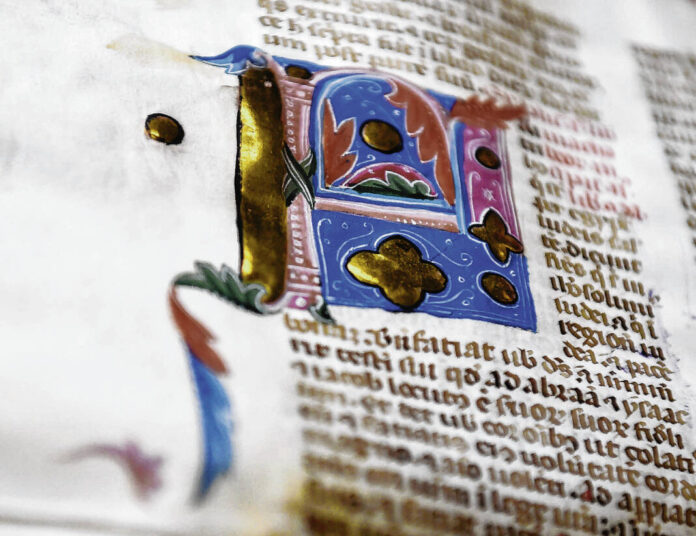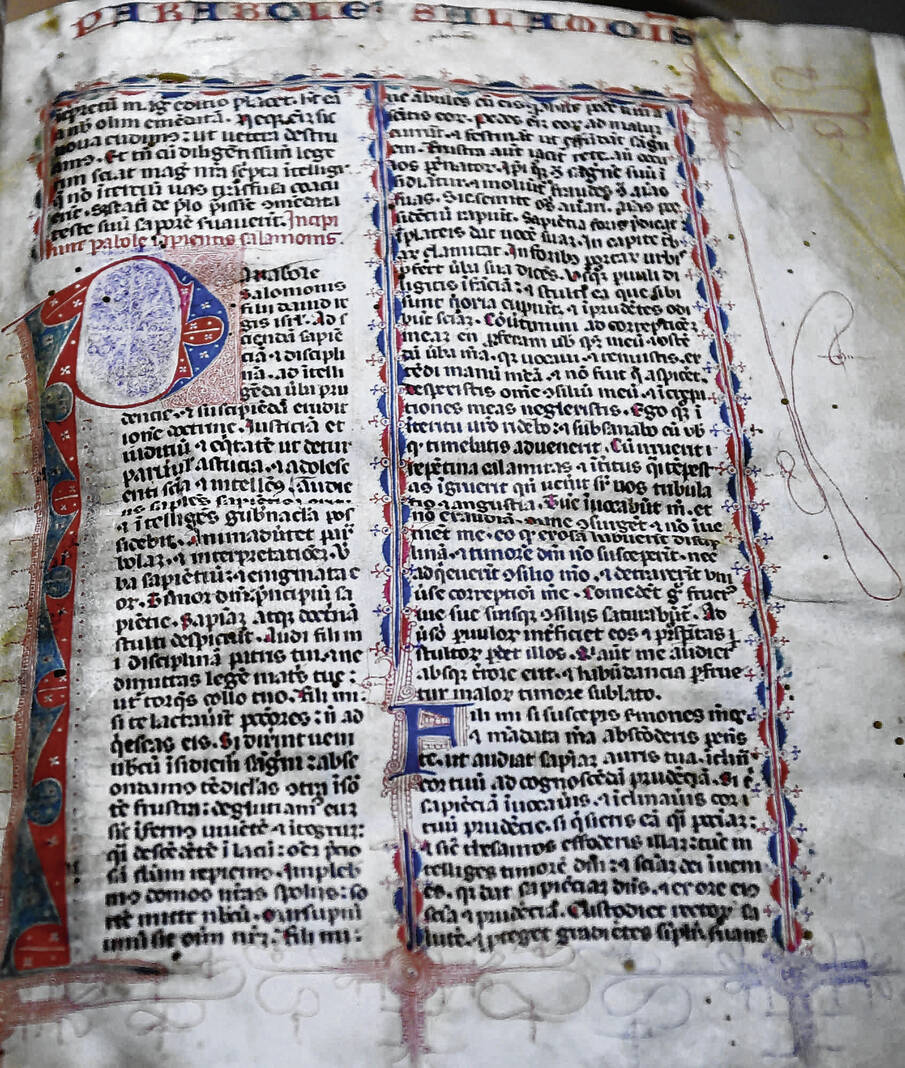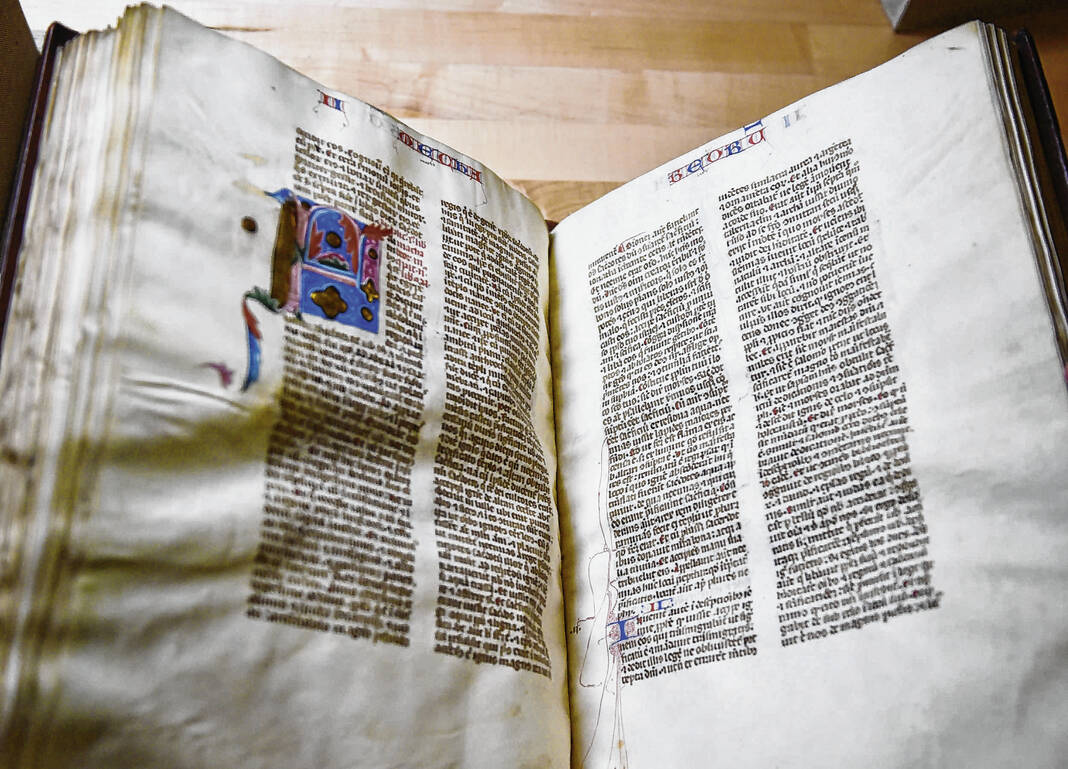The medieval treasure had been hidden away in downtown Indianapolis for years.
Two bound manuscripts of the Bible, with ornate illuminations and flowing script, had been painstakingly created by medieval scribes and illuminators in the 14th century. Over more than 700 years, the books had made their way from Europe to Indiana, eventually ending up in the possession of an Indianapolis resident.
And finally, the tomes became part of the collection of the Indiana State Library.
“It’s kind of a historical fluke that we even have this,” said Seth Irwin, conservator at the Indiana State Library. “But it’s here. It’s part of the state library’s collection. Everybody owns it; it’s public property.”
Known as the Darlington Bible, the books have been rediscovered in the state library, restored and repaired over the summer in order to be available to the public.
Library officials have planned a special program today that investigates the origin of the book as well as the manuscript’s movement from medieval Spain to Indiana. Experts in medieval Bibles as well as historical text conservators will place the manuscript in the larger context of medieval Bibles.
“Anyone who wants to come in and look at them, they’re welcome to do that,” said Marcia Caudell, supervisor of the reference and government services division at the Indiana State Library. “We don’t have anything in this library that people cannot look at, unless it’s in the lab. We may tell you where to look at it, but you can come in and see it.”
The Bible had been in private hands for at the past 200 years, until it came into the collection of Frank Darlington Sr., an Indianapolis resident.
After Darlington died in the early 20th century, his son gave the Bible and much of his father’s book collection to the Indiana State Library in 1953.
“It is, to the medieval scholar world, it is unknown. It is brand new. There has never been a scholarly study of it, because it had lived in private hands for at least the last 200-something years,” Irwin said. “It also hasn’t seen a lot of usage, which is why the pigments are in such incredibly good shape.”
As the library examined the Bible, they reached out to Dr. David T. Gura, curator of ancient and medieval manuscripts at the Hesburgh Library at the University of Notre Dame as well as a concurrent associate professor at the university’s Medieval Institute.
For two days, Gura studied and examined the manuscript. His research helped unlock some of the Bible’s secrets.
According to his research, the Darlington Bible is a 14th century medieval Bible copied in Catalonia. The text is that of the Vulgate, St. Jerome’s Latin translation, so the Bible, its introductory prologues, and glossary of Hebrew names are all completely in Latin.
When the Bible was acquired, the state library featured it in an opening exhibit. But afterwards, it was returned to the library’s closed stacks, where it had mostly been forgotten about, Caudell said.
“It’s not been unknown to us. Occasionally, someone would come to look at it, but not anyone with that knowledge of medieval text,” she said.
Over the course of the summer, Irwin and others in the conservator office at the library have worked to repair the binding of the Bibles. Portions of the spine had completely worn away, and conservators had to remove the old spine and create a new one using Japanese tissue, Western paper, cloth and goat leather.
Other than some damage from water and insects over the years, the manuscripts are in incredibly good condition, Irwin said.
“The interior of the book we didn’t do anything with. Thankfully, it’s in beautiful condition, so there was no pigment loss or flaking,” he said.
Rebound and ready to be stored in specially made, padded protective boxes, the manuscripts are available to the public to examine if they’d like, Irwin said.
The first opportunity to see it will be today during the free program titled “The Mystery of the Darlington Bible.” Gura, Irwin and Caudell will all present on the Bible. People will also be able to see it on display.
The manuscripts will go back into protective storage afterwards. But because the state library is a public institution, researchers and state residents have the opportunity to examine it at the library itself.
“It’s Indiana-related because of the donor, but we’re not an exhibiting institution. We’re hoping that other institutions might want to use it for exhibits,” Irwin said. “It’s a publicly owned item now. Everybody owns this. It’s Indiana’s Bible. We’re hoping it gets some more attention and studied more.”









